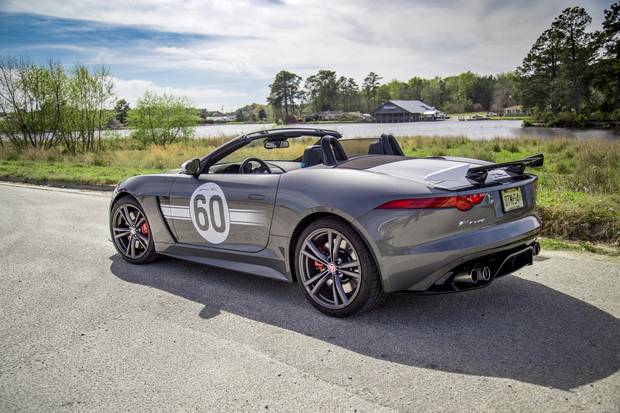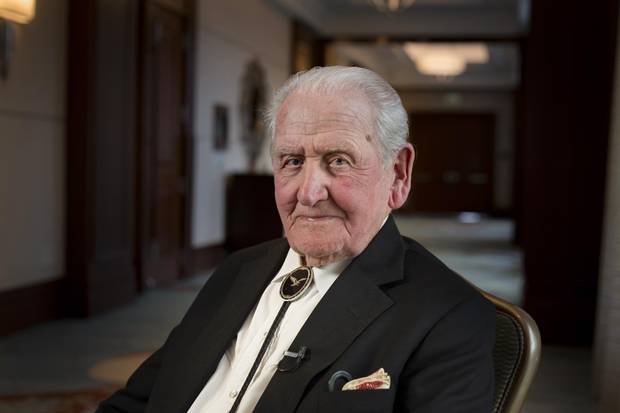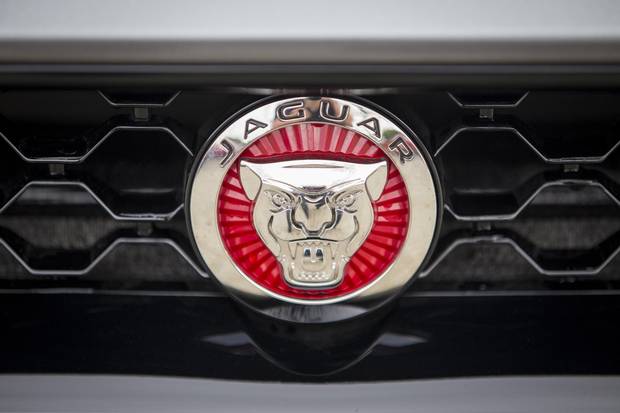The police officer directing traffic out of the concourse parking lot blinks, makes eye contact, and says, "This one of them Ferraris?"
No sir, a Jaguar. F-Type. SVR.
"Well, you can jump on it," he says, signalling oncoming traffic to yield. "Just don't go crazy."
However resolute the driver's sanity may be, the Jag itself goes bonkers whenever the supercharged V-8 senses the accelerator pedal is in extremis. The SVR's titanium exhaust was engineered to issue a primal scream each and every time.
We catapult out of the parking lot as a jet would from an aircraft carrier. For you, officer! There's a polite absence of tire squeal given the all-wheel-drive, but the V-8's growl instantly becomes baritone bark – such rage, but I feel better now – en route from zero to 100 kilometres an hour in a claimed 3.7 seconds.

The Jaguar F-Type is worthy of its name.
JAGUAR LAND ROVER
Then, an incredible series of snaps, crackles and pops as the throttle is released for slower traffic as though the active valves in the rear silencers are nuclear Rice Krispies. The single most exciting thing about this F-Type SVR convertible, which sells for $145,000, is the exhaust system. Otherwise, its civility predominates.
And with the Amelia Island Concours d'Elegance featuring the D-Type Jaguars that dominated the 1957 Le Mans endurance race, a fleet of F-Type SVRs were assembled to mark the 60th anniversary of that triumph over Ferrari.
A fellow in a vintage Mercedes-Benz 500SL lost all control, coming upon the SVR in bumper-to-bumper traffic departing Atlanta. He phoned friends, took pictures, gestured to lower the window for conversation. A waitress at the Jomax Bar BQ said with a beguiling smile she'd marry this car.
Jaguar also brought 96-year-old Norman Dewis to Amelia to mark the occasion. Earnest and eloquent, Dewis's every tale recalls an era when Jaguar brought glory to England, long before being taken over by British Leyland, then Ford, now India's Tata.
As test driver and development engineer from 1952 through 1985, he helped create the disc brakes with which the C-Types finished one-two in 1953, then developed the D-Types, later the classic 1961 E-Type sports car, along with all of the sedans up to the 1986 XJ40.
His role in the F-Type is strictly promotional, yet such is his credibility that Top Gear featured him with the SVR last June, before the car went on sale.

Norman Dewis was a test driver and development engineer for Jaguar.
Handout
He'd fought in the war; Germany remained the enemy when he learned Mercedes-Benz was developing the 300 SLR for the 1955 race. "The hunting ground," is how he references Le Mans to this day.
He remembers passing a Mercedes in that race, "at 192 miles per hour, down the Mulsanne straight in a D-Type long-nose with a full-round windscreen." Dewis's racing ceased when company founder William Lyons declared that drivers were replaceable, but his development engineer was not.
After the D-Type, Dewis's "other favourite Jaguar would be the E-Type. The perfect shape. Park that car anywhere, observe what happens: People walking by will turn their heads – ordinary people, not lunatics like us."
The F-Type we're driving, if shorn of its outsized numbers, graphics and carbon-fibre spoiler, likely wouldn't capture the attention of anyone other than devotees intimate with its 575 horsepower and 314-km/h capability.
Topping the E-Type was never in the cards, Ian Callum, Jaguar's director of design, said at the F-Type's unveiling. A hood that low and beguiling would endanger pedestrians, by current industry standards.

The Jaguar F-Type offers a quality ride at legal speeds.
Jaguar Land Rover
So what makes this car worthy of the name? Its ride quality at legal speeds, its handling beyond them. The near-silence at 100 km/h, the engine loafing along below 1,500 rpm. The fireworks of that titanium and Inconel exhaust on the way to 6,500 as the eight-speed automatic snaps through the gears.
A sign of Jaguar reimagined: Michael Quinn, the grandson of Lyons, who accompanied Dewis to Amelia, lost his family's Jaguar franchise late in December. R.A. Creamer & Son, in Kensington, had sold Jaguars to the Royal Family for decades.
" Tata requires Jaguar dealerships to meet certain standards that weren't possible in our location," Quinn said. "Such as a provision for parking." He's opening a new business later this year, selling classic cars of the order of the E-Type he's raced in vintage events over the past 20 years. In all matters Jaguar, the future is forever linked with the past.
